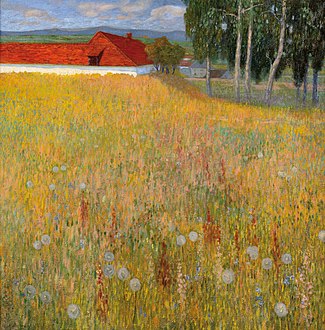Hugo Baar
This article needs additional citations for verification. (December 2016) |

Hugo Baar (3 March 1873, Nový Jičín – 18 June 1912, Munich) was a Moravian-German landscape painter.
Biography[edit]
His father was a merchant. After attending a German gymnasium, he learned weaving at a local arts and crafts school from 1889 to 1892. Later, he was able to enroll at the Academy of Fine Arts, Vienna, where he studied with the landscape painter, Rudolf Ribarz, and the Academy of Fine Arts, Munich, where his primary instructors were Gabriel von Hackl and Heinrich Knirr.[1]
In 1903, he married the daughter of a hat factory manager and had his first showing in Vienna, where he participated in an exhibition staged by the Hagenbund and became a member of that group. The following year, he had a solo exhibition in Olomouc, near his birthplace. After resettling there, he made the acquaintance of Bohumír Jaroněk, a member of the "Association of Moravian Artists" (SVUM) who enabled him to exhibit with that organization. In 1907, he was one of the founding members of the local Museum Association.[1]
He also exhibited in Brno with the "Mährischer Kunstverein", the German equivalent of the SVUM. At this time, he came under the influence of Gustav Klimt and was associated with the Vienna Secession. Later he helped establish the "Association of German-Moravian Visual Artists" in Brno and became its Vice-Chairman. The Chairman was Hugo Charlemont, but Baar organized all of the group's activities.
In 1910, he travelled extensively throughout Germany, Belgium and the Netherlands. He died suddenly in 1912, while working on a contract for lithographs, in Munich.[1]
Selected paintings[edit]
-
Meadow Landscape
with Farm -
Winter Landscape
-
Mountain Path in the Beskids
-
Evening Mood
References[edit]
- ^ a b c Brief biography @ Galerie Osobností.
Further reading[edit]
- Eva Trnková, Hugo Baar: Obrazy (exhibition catalog), Muzeum Novojičínska, 1993
External links[edit]
- ArtNet: More works by Baar.
- Hugo Baar @ abART
- 1873 births
- 1912 deaths
- People from Nový Jičín
- Artists from the Margraviate of Moravia
- Moravian-German people
- Austrian landscape painters
- 19th-century Austrian painters
- 19th-century Austrian male artists
- Members of the Vienna Secession
- Academy of Fine Arts Vienna alumni
- Painters from Austria-Hungary
- Emigrants from Austria-Hungary to Germany




